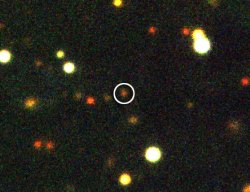NASA's Gamma-ray Burst Capturer captured the largest explosion ever observed, 9,000 times the size of an average supernova, which occurred 12.2 billion years ago

The burst was captured by the gamma-ray Fermi Space Telescope (formerly GLAST) on September 15, 2008, and its power is about 9,000 ordinary supernovae (a supernova is the explosion of a massive star). Assuming the energy spread uniformly in all directions, although gamma ray bursts are usually fired in a thin jet.
"We've been waiting for one like this," said Peter Michelson, principal investigator of the Fermi Large Space Telescope at Stanford University. "Eruptions with such energies are still barely recognized, and Fermi gives us the tools to understand them."
The burst, dubbed GRB 080916C, occurred in the Carina group. Fermi's wide-lens telescope and gamma-ray monitoring system picked up energies 300 to 5 billion times more powerful than what could be seen in visible light during the initial burst.
Gamma-ray bursts are the universe's largest light shows by any measure, yet this burst released more energy in the initial emission than any previous burst.
Astronomers believe that these explosions occur when very massive stars run out of nuclear fuel. The core of the star collapses and turns into a black hole, while jets of matter, driven by a process that is not yet clear to scientists, burst out almost at the speed of light. Ground-based observations of the same source led the researchers to conclude that the eruption occurred 12.2 billion years ago, when the universe was only 1.5 billion years old - and its light has only now reached Earth.

10 תגובות
Shmulik:
Inflation is part of the standard model of cosmology and you can read about it here:
http://en.wikipedia.org/wiki/Cosmic_inflation
In general, you should start reading about the subject of the formation of the universe - starting with the Big Bang - at the following link:
http://en.wikipedia.org/wiki/Big_bang
One of the Jewish Nobel laureates - Steven Weinberg - once wrote a book on the subject of the Big Bang - under the title "The First Three Minutes"
http://www.amazon.com/First-Three-Minutes-Modern-Universe/dp/0465024378/ref=pd_bbs_sr_1?ie=UTF8&s=books&qid=1235402689&sr=8-1
I don't know how long the inflation lasted and in fact the subject is still not really understood in general.
It is possible that there is a connection between inflation and dark energy (which is also not fully understood) which results in the speed of the stars moving away from each other accelerating even nowadays.
Walla I did not know
I already thought I had rediscovered the paradox of the age of the universe 🙂
How long did the rapid rate of expansion last?
Where can I read about it? (what is the name of the phenomenon)
Shmulik:
Because of inflation the rate of expansion of the universe was much greater than the speed of light.
Something is still unclear
If the eruption happened 1.5 billion after the beginning of the universe
So how did we manage to stay away from the eruption a distance of 12 billion light years?
Not every star is equally stable. Especially big ones. They usually have the shortest lifespan because they burn their fuel faster and the length of each stage of their life is shorter (there is a division according to the state of the star). Our star, the Sun, for example, is considered relatively small, so its lifespan is estimated to be several billion years (Only the main phase of his life is estimated to last about 10 billion years).
Here is a link with a simple explanation, there are probably more detailed links on the net:
http://he.wikipedia.org/wiki/%D7%9B%D7%95%D7%9B%D7%91#.D7.94.D7.95.D7.9C.D7.93.D7.AA.D7.9D.2C_.D7.9E.D7.94.D7.9C.D7.9A_.D7.97.D7.99.D7.99.D7.94.D7.9D_.D7.95.D7.9E.D7.95.D7.AA.D7.9D_.D7.A9.D7.9C_.D7.94.D7.9B.D7.95.D7.9B.D7.91.D7.99.D7.9D
And nothing happened to us
Wait, if the star has finished all the fuel, which according to my understanding should take quite a number of billions of years, how can it be that the star has exhausted its life drum !<% billion years in the best case that it was born at the moment of the creation of the universe??
"When the universe was only between 1.5 billion years old"
Thanks. fixed.
Yimar Blizovsky, you have a typographical error: you wrote "Khoresh Shavor" instead of "Hor Shavor".
How small is so big